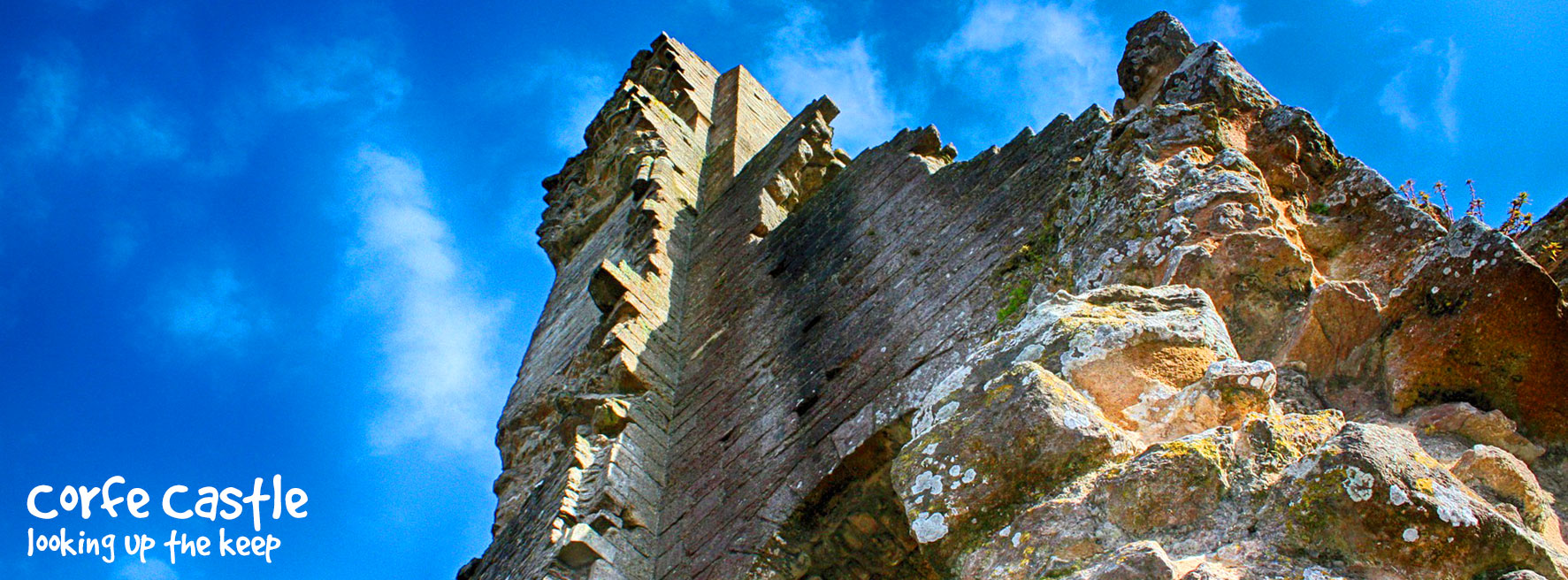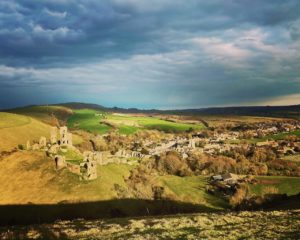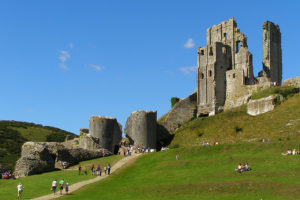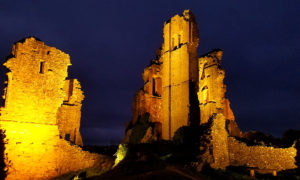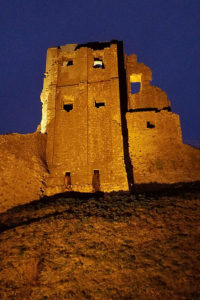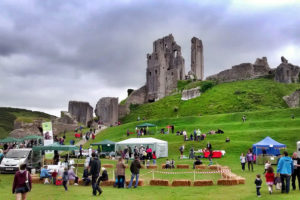
Corfe Castle Opening Times
The castle is usually open 10am – 5pm during the summer and 10am – 4pm in the winter.
Please see new 2024 Entry Prices below.
Corfe Castle is open every day, and you don’t need to book your visit in advance!
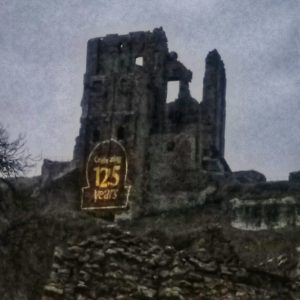
History ~ How Old is Corfe Castle
Corfe Castle dates to about the 11th century, with the first phase of construction thought to have been one of the earliest castles in England to be built partly using stone — at the time the majority were made of earth and timber. In the 12th and 13th centuries, Corfe Castle underwent major changes and likely stayed similar for the rest of its active use.
In 1572, Corfe Castle left the Crown’s control when Elizabeth I sold it to Sir Christopher Hatton, then Sir John Bankes bought the castle in 1635, and the owner during the English Civil War. His wife Lady Mary Bankes led the defence of the castle when it was twice besieged by Parliamentarian forces. The first siege, in 1643 was unsuccessful, but by 1645 when Corfe was one of the last remaining royalist strongholds in southern England it fell to a siege ending in an assault. In March that year, Corfe Castle was slighted (destroyed) on Parliament’s orders.
Now owned by the National Trust, the castle is open to the public daily (excluding Christmas). It is protected as a Grade I listed building and a Scheduled Ancient Monument.
Visiting the Castle
When visiting the Castle, you can either park in the village which offers limited free parking for up to 1 hour (just enough time to explore the castle), or you can use one of the pay and display car parks — West Street Car Park is situated in the village, the National Trust Visitor Centre car park can be found at the base of the castle (free to NT Members). There is also the Purbeck Park car park situated at Norden, which is handy if you plan to ride on the Swanage Steam Railway (seasonal trains run from Norden Holt to Corfe Castle before journeying on to Swanage).
Wherever you park, the Castle will be visible — there are a number of signposted footpaths and routes leading to the entrance, which can be found via the Village Square. If you are uncertain of the best route, ask the first person you see, they will be sure to point you in the right direction.
Tickets and Entry to the Castle
You can either book your tickets online at the National Trust website or pay at the ticket office, which can be found just off the Village Square next to the National Trust Tea Room.
Prices
Corfe Castle is open every day (except 25 and 26 December)
National Trust Members: free.
Under 5s: free.
Child price applies for 5-17 year olds (inclusive).
Family ticket admits two adults plus up to three children.
Peak Season dates for 2023:
Saturday 1 April – Sunday 16 April
Saturday 29 April – Monday 1 May
Saturday 27 May – Sunday 4 June
Saturday 24 June – Sunday 3 Sept
Saturday 21 October – Sunday 29 October
Off Peak Prices:
Adult – £11.00
Child – £5.50
Family – £27.50
Family (1 Adult) – £16.50
Under 5s free
Peak Prices:
Adult – £12.00
Child – £6.00
Family – £30.00
Family (1 Adult) – £18.00
Under 5s free
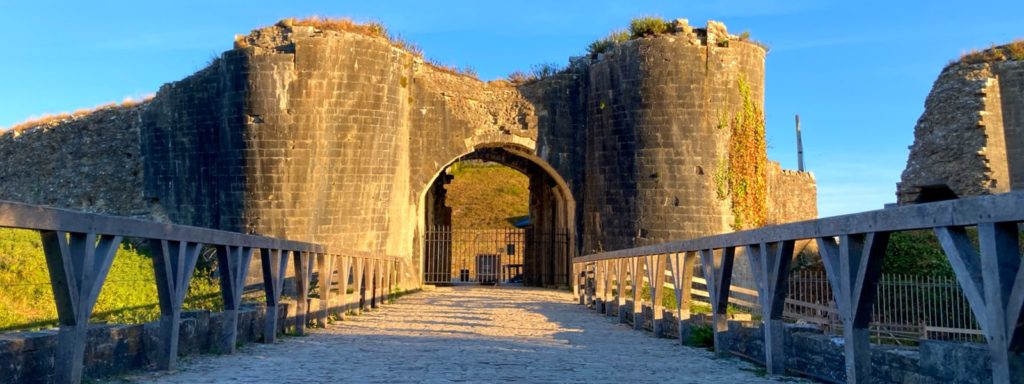
The entrance to the Castle is across a spectacular stone bridge over the now dry moat. As you pass through the main entrance, you will be asked to show your tickets before exploring the Castle.
The castle is usually open 10am – 5pm during the summer and 10am – 4pm in the winter.
More information about visiting Corfe Castle can be found on the How to Get Here page.
Q: Why is Corfe Castle famous?
Corfe Castle is a famous for its rich history and well-preserved ruins. The castle dates back to the 11th century and played a significant role in the English Civil War. It was also the site of the murder of King Edward the Martyr in 978 AD. The castle’s long history, dramatic setting and well-preserved ruins make it a popular tourist destination. It was owned by National Trust since 1982 and open for visitors all year round.
Q: How long does it take to go around Corfe Castle?
The time it takes to explore Corfe Castle can vary depending on how long you spend at each area of the site and how much you want to see. A general visit to the castle could take around 1-2 hours, but if you want to take your time and explore in more detail, it could take longer. It also depend on the number of people visiting the castle at the same time, as it can get busy and crowded during peak seasons.
Q: Why is Corfe Castle destroyed?
Corfe Castle was destroyed by parliamentarian forces during the English Civil War in the 17th century. The castle had been held by Royalist forces, and it was considered a strategic stronghold by both sides. In 1643, the castle was besieged by parliamentarian forces for several months before it fell. After the castle was captured, the parliamentarian commander ordered that the castle be slighted, meaning that the fortifications were deliberately destroyed to prevent it from being used again as a military stronghold.
Q: Can you see Corfe Castle without paying?
It is possible to see Corfe Castle without paying, but the views of the castle are limited. The castle is located in the village of Corfe Castle and it is surrounded by a public footpath that allows visitors to walk around the base of the castle. From this footpath, you can see the castle from a distance, but you won’t be able to enter the castle or explore the ruins. The views from the footpath will not be as good as the ones from inside the castle, but it can give you an idea of the castle’s size and location.
Ten Fun Facts About Corfe Castle
- Corfe Castle is located in the village of Corfe, in the English county of Dorset. It is located on the isle of Purbeck, which is actually a peninsula rather than an island (see How to Get here).
- The castle was built on the hill above the village and guards the only natural route through the Purbeck Hills. The name Corfe comes from an old English word meaning cutting, or gap.
- The castle was built by William the Conqueror, during the 11th century, for defensive purposes. It was one of the first stone castles in England; most earlier castles were built with wood and earth.
- The surrounding landscape has many Bronze Age burial sites, and the area around Corfe Castle has been occupied for thousands of years. The National Trust have banned metal detectors from being used on the site.
- During Medieval times, Corfe became a Royal castle and King John kept his crown jewels there.
- The original arrow slits and murder holes can still be seen in the castle. The murder holes were used for pouring boiling water on anyone trying to attack the castle.
- Corfe Castle was largely demolished during the Civil War, under orders from Parliament. Over the years, many villagers used the stones to build their own houses.
- Ravens nest at Corfe Castle; local legend says the castle will crumble if the birds leave. Buzzards, peregrine falcons, red kites and redstarts can also be seen around the castle.
- One of the most famous British writers was inspired by Corfe Castle. Children’s author Enid Blyton used it as the basis for her Kirrin Island in the Famous Five series of books.
- The castle regularly hosts events and living history days in which volunteers dress, eat and live as they would have done in Norman and Medieval times.
Corfe Castle – 3D Historical Reconstruction (video).
Part of a final year project for Computer Animation course at University of Portsmouth by Ciprian S
Bit of more History
Corfe Castle is built on a steep hill in a natural gap in a long line of chalk hills, created by two streams eroding the rock on either side. The name Corfe derives from the Old English ceorfan, meaning ‘a cutting’, referring to the gap and in Saxon times it was known as Corfe Gate.
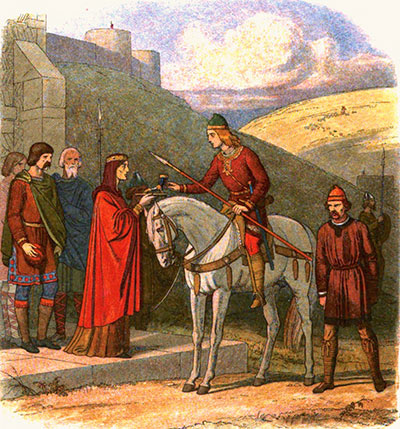
The construction of the medieval castle means that little is known about previous activity on the hill. It’s know from contemporary writing that Anglo-Saxon nobility treated it as a residence, such as Queen Ælfthryth, wife of Edgar, and there are postholes belonging to a Saxon hall on the site. This hall may be where the boy-king Edward the Martyr was assassinated in 978; contemporaries tell us that he went to the castle at Corfe to visit Ælfthryth and his brother.
Edward the Martyr (Old English: Eadweard) lived from 962 to 18th March 978. He was King of England from 975 until he was murdered in 978. Edward was the eldest son of King Edgar the Peaceful but was not his father’s acknowledged heir (read more about St Edward the Martyr)
This year was King Edward slain, at eventide, at Corfe-gate, on the fifteenth day before the calends of April. And he was buried at Wareham without any royal honour. No worse deed than this was ever done by the English nation since they first sought the land of Britain.
— The Anglo-Saxon Chronicle (written late 9th century)
Edward’s date of birth is unknown, but he was the eldest of Edgar’s three children. He was probably in his teens when he succeeded his father, who died at age 32 in 975. Edward was known to be King Edgar’s son, but he was not the son of Queen Ælfthryth, the third wife of Edgar.
Edward’s short reign was brought to an end by his murder at Corfe Castle in 978 in circumstances that are not altogether clear. His body was reburied with great ceremony at Shaftesbury Abbey early in 979. In 1001 Edward’s remains were moved to a more prominent place in the abbey, probably with the blessing of his half-brother King Æthelred. Edward was already recognised as a saint by this time.
A number of lives of Edward were written in the centuries following his death in which he was portrayed as a martyr, generally seen as a victim of the Queen Dowager Ælfthryth, mother of Æthelred. He is today recognized as a saint in the Eastern Orthodox Church, the Catholic Church, and the Anglican Communion.
